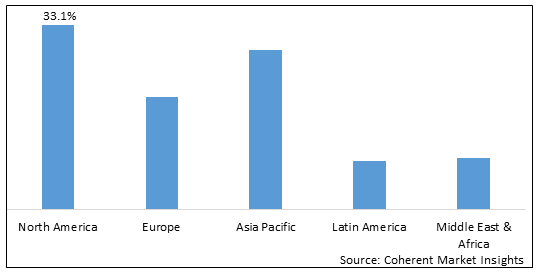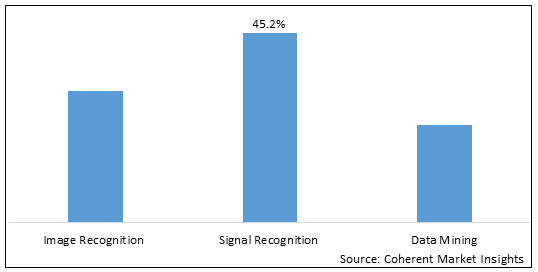Neuromorphic Chip Market is estimated to be valued at USD 125.39 Bn in 2025 and is expected to reach USD 4,599.75 Bn in 2032, exhibiting a compound annual growth rate (CAGR) of 67.3% from 2025 to 2032.
Neuromorphic chips are digital and analog integrated circuits that implement neural networking technology. Neuromorphic computing is executed on hardware by threshold switches, transistors, and oxide-based memristors. These electronic chips mimic the human brain and are made up of millions of neurons. The architecture of a neuromorphic chip consists of numerous artificial neural networks. Neuromorphic chips are implemented in advanced tools for experimentation. Neuromorphic chips find applications in image recognition, single recognition, and data mining processes among others.
Global Neuromorphic Chip Market: Regional Insights
Global Neuromorphic Chip Market is segmented divided into North America, Europe, Asia Pacific, Latin America, and the Middle East & Africa.
North America shows significant growth in the neuromorphic chip market during the forecast period, because of the key players in the region who are adopting to automation and robotics technology with the help of growing investments on research and development. Development of miniature ICs in the region is leading to growing demand for artificial intelligence and rising trend for small sized devices that are compact. This factor helps in driving the market.
Few more thing driving the market in the North America region are rapid speed in technological advancements, in terms of innovations in products, and rising industry wide applications of neuromorphic chips, which has Internet of Things (IoT) inbuilt in them. The market accelerates because of more people are adopting machine learning, Natural Language Processing (NLP), image processing, and recognition of speech in healthcare, automotive, and consumer electronics. Many key players are making progress in new innovative products in the market to achieve the edge in the competition. For instance, in January 2022, BrainChip, is a Artificial intelligence company, has announced the commercialization of its Akida Neural Networking Processor, which is used for Internet of Things (IoT) and various edges. That is a neuromorphic AI Chip, which can give ultra-low power and performance benefits over conventional approaches.
Figure 1: Global Neuromorphic Chip Market Share (%), By Region, 2025

To learn more about this report, Download Free Sample
Global Neuromorphic Chip Market- Drivers
Increasing demand for artificial intelligence systems
Increasing demand for artificial intelligence systems is expected to drive growth of the global neuromorphic chip market during the forecast period. Numerous companies and researchers are incorporating neuromorphic chips in artificial intelligence systems to enhance processes including speech recognition, machine learning, image recognition, data mining, automated reasoning, etc. Rising use of neuromorphic chips in artificial intelligence has received excellent response from various end users worldwide. This is typically due to extraordinary developments it has brought in mobile phone speech recognition, robots automating operations, driverless cars, and others. Moreover, its capabilities of solving problems by employing a complex pattern-matching process similar to a human brain is another factor expected to drive growth in the global neuromorphic chip market during the forecast period.
Integration of smart machines
Integration of smart machines is expected to propel the global neuromorphic chip market growth over the forecast period. Smart machines are based on cognitive computing and artificial intelligence and have emerged as major trends across the globe. Smart machine manufacturers are integrating neuromorphic chips into their systems, in order to enhance overall performance. Furthermore, the ability of these systems to learn from their surroundings and interactions and respond suitably without the need for pre-programming is encouraging the adoption of these smart machines in lieu of conventional machines.
Global Neuromorphic Chip Market- Opportunities
Conjunction of next-generation strategies
Conjunction of next-generation strategies can present lucrative growth opportunities. Neuromorphic chips represent significant opportunities in terms of being implemented along with other advanced technologies such as artificial intelligence, big data, and others in the coming years. Integration of neuromorphic chips improves the pattern recognition quality in artificial intelligence systems; whereas, in big data, neuromorphic chips advance the data mining and forecasting processes. Manufacturers engaged in the development of these technologies can enter into partnerships and collaboration with manufacturers of artificial intelligence systems to strengthen and establish position in the market.
Integration in portable consumer devices
Integration in portable consumer devices to pose significant business opportunities. Neuromorphic chips have vast opportunities in the smartphone and smartwatch market in the near future. Pattern recognition issues are prime areas for manufacturers to focus on improving in smartphones. Integration of neuromorphic chips into mobile devices will improve the device’s audio and visual processing skills. Moreover, prominent manufacturers of these chips such as IBM Corp., Qualcomm Inc., and others are working towards developing their own neuromorphic technology, which will be suited for applications in mobile phones.
Neuromorphic Chip Market Report Coverage
| Report Coverage | Details | ||
|---|---|---|---|
| Base Year: | 2024 | Market Size in 2025: | USD 125.39 Bn |
| Historical Data for: | 2020 To 2024 | Forecast Period: | 2025 To 2032 |
| Forecast Period 2025 to 2032 CAGR: | 67.3% | 2032 Value Projection: | USD 4,599.75 Bn |
| Geographies covered: |
|
||
| Segments covered: |
|
||
| Companies covered: |
IBM Research, Inc., Knowm Inc., Intel Corp., BrainChip Holdings Ltd., General Vision Inc., HRL Laboratories, LLC, Qualcomm Technologies Inc., and Hewlett Packard Labs. |
||
| Growth Drivers: |
|
||
| Restraints & Challenges: |
|
||
Uncover macros and micros vetted on 75+ parameters: Get instant access to report
Global Neuromorphic Chip Market-Trends
Neuromorphic chips are being widely used for image recognition applications
Neuromorphic chips are being widely used for image recognition applications. In the recent past, several problems associated with image recognition processes such as low-contrast images, blurred images, noisy images, image conversion to digital form, storage of large-volume images and others, has led to the development of efficient image processing and recognition algorithms. Neuromorphic technology has resolved some issues related to digital image processing through its parallel architecture. Moreover, neuromorphic chips find application in pattern recognition, face recognition, texture analysis, color representation, and several other aspects of image processing.
Driverless cars as well as advanced driver assistance systems represent major opportunities
Currently, the use of neuromorphic chips is limited to specific industries and applications. The number of chips manufactured currently is limited, as most are in the research phase and some are prototype models. There are ample opportunities available in terms of applications for neuromorphic chips, however, are yet to be explored. Driverless cars as well as advanced driver assistance systems represent major opportunities for these chips in the automotive industry. Moreover, rescue robots, drones, and unarmed aerial vehicles used in aerospace and defense sectors represent the future outlook for the neuromorphic chips market.
Global Neuromorphic Chip Market- Restraints
Challenges associated with the development of complex algorithms
Challenges associated with the development of complex algorithms are expected to hinder the global neuromorphic chip market growth over the forecast period. Neuromorphic chips are required for the development of complex algorithms, which can be time-consuming. Neuromorphic chips require algorithms that are not too long as it may result in increase in memory consumption, and may be prone to errors. Furthermore, the development of algorithms that can accelerate the working of a neural network may also require skilled professionals, which in turn, adds to cost production. Thus, these factors are expected to hinder the market growth over the forecast period. For instance, Hewlett Packard Labs(HP), technology company, developed a conversion algorithm to reduce computational errors and maximize computing accuracy of its neuromorphic technology.
Slow commercialization and high cost of neuromorphic chips
Slow commercialization and high cost of neuromorphic chips is expected to restrain growth of the global neuromorphic chip market during the forecast period. The slow rate of commercialization as well as high cost of neuromorphic chips is a major restraining factor for growth of the market. Furthermore, high cost and limited choice among several manufacturers offering neuromorphic chips are constraining OEMs in various industries from integrating these chips in their products.
Figure 2: Global Neuromorphic Chip Market Share (%), By Vertical, 2025

To learn more about this report, Download Free Sample
Global Neuromorphic Chip Market- Segmentation:
Global Neuromorphic Chip Market report is segmented into application, vertical, and region.
Based on vertical, the market is segmented into aerospace and defense, automotive, consumer electronics, Healthcare, Industrial and others. Consumer Electronics accounted for the largest share of 4% in the global neuromophic chip market and is expected to be valued US$ 3,000.6 million by 2032. This is owing to increased demand for artificial intelligence and machine learning in consumer electronics devices.
Global Neuromorphic Chip Market: Key Developments
Global Neuromorphic Chip Market: Key Companies Insights
Global Neuromorphic Chip Market is highly competitive, owing tocontinuous launch of new technologies due to ongoing R &D and efforts by value chain participants. Moreover, key players are adopting various business growth strategies, in order to expand their presence on regional as well as global basis.
Some of the key players in the Global Neuromorphic Chip Market are Cadence Design Systems, Inc., Altium LLC, WestDev Ltd., Zuken Inc., AutoDesk Inc. Ansys, Inc., and Synopsys, Inc.
*Definition: Neuromorphic chips are digital and analog integrated circuits that implement neural networking technology. Neuromorphic computing is executed on hardware by threshold switches, transistors, and oxide-based memristors. Neuromorphic chips are implemented in advanced tools for experimentation. Neuromorphic chips find applications in image recognition, single recognition, and data mining processes among others.
Share
Share
About Author
Suraj Bhanudas Jagtap is a seasoned Senior Management Consultant with over 7 years of experience. He has served Fortune 500 companies and startups, helping clients with cross broader expansion and market entry access strategies. He has played significant role in offering strategic viewpoints and actionable insights for various client’s projects including demand analysis, and competitive analysis, identifying right channel partner among others.
Missing comfort of reading report in your local language? Find your preferred language :
Transform your Strategy with Exclusive Trending Reports :
Frequently Asked Questions
Select a License Type
Joining thousands of companies around the world committed to making the Excellent Business Solutions.
View All Our Clients